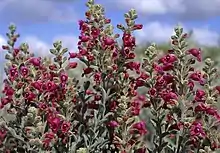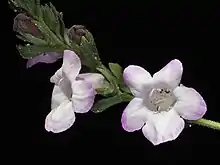| Dasymalla | |
|---|---|
 | |
| Dasymalla terminalis near Mullewa | |
| Scientific classification | |
| Kingdom: | Plantae |
| Clade: | Tracheophytes |
| Clade: | Angiosperms |
| Clade: | Eudicots |
| Clade: | Asterids |
| Order: | Lamiales |
| Family: | Lamiaceae |
| Subfamily: | Prostantheroideae |
| Genus: | Dasymalla Endl.[1] |
| Species | |
|
See text | |
Dasymalla is a genus of five species of flowering plants in the mint family, Lamiaceae and is endemic to Western Australia. Plants in this genus are woolly shrubs with five petals joined to form a tube-shaped flower with four stamens of unequal lengths. These species are similar to those in the genus Pityrodia except that the fruit does not release its seeds when mature.
Description
Plants in the genus Dasymalla are evergreen shrubs densely covered with woolly hairs. The leaves are simple, egg-shaped, arranged in opposite pairs and covered with woolly hairs. The flowers are arranged singly in leaf axils and have five sepals which are joined at their base forming a short tube with five lobes. The five petals form a curved tube with five lobes on the end, the upper lobes shorter than the lower ones. There are four stamens with the lower pair shorter than the upper ones. The fruit does not release its seeds when mature and has a pronounced hump.[2]
Taxonomy and naming
The genus was first described by Stephan Endlicher in 1839 and the description was published in his book Novarum Stirpium Decades.[3][4] In 1979, Ahmad Abid Munir transferred Dasymalla axillaris and Dasymalla terminalis described by Endlicher and Chloanthes teckiana described by Ferdinand von Mueller to Pityrodia. He also formally described Pityrodia chlorisepala and Pityrodia glutinosa.[5] In 2011, Barry Conn, Murray Henwood and Nicola Streiber resurrected the genus Dasymalla and transferred these five species to it.[2]
The names of five species of Dasymalla are accepted by the Australian Plant Census:[6]
- Dasymalla axillaris Endl.
- Dasymalla chorisepala (Munir) B.J.Conn & M.J.Henwood
- Dasymalla glutinosa (Munir) B.J.Conn & M.J.Henwood
- Dasymalla teckiana (F.Muell.) B.J.Conn & M.J.Henwood
- Dasymalla terminalis Endl.
Distribution
All species of Dasymalla are endemic to Western Australia,[7] although D. chorisepala also occurs in the Northern Territory near its border with Western Australia.[8]
References
- ↑ "Dasymalla". Australian Plant Census. Retrieved 28 May 2023.
- 1 2 Conn, Barry J.; Henwood, Murray J.; Streiber, Nicola (2011). "Synopsis of the tribe Chloantheae and new nomenclatural combinations in Pityrodia s.lat. (Lamiaceae)". Australian Systematic Botany. 24 (1): 1–9. doi:10.1071/SB10039.
- ↑ "Dasymalla". APNI. Retrieved 30 November 2016.
- ↑ Endlicher, Stephan (1839). Novarum Stirpium Decades (Volume 2). Paris. p. 11. Retrieved 30 November 2016.
- ↑ Munir, Ahmad Abid (1979). "A taxonomic revision of the genus Pityrodia (Chloanthaceae)". Journal of the Adelaide Botanic Garden. 2 (1): 1–138.
- ↑ "Dasymalla". Australian Plant Census. Retrieved 28 May 2023.
- ↑ "Dasymalla". FloraBase. Western Australian Government Department of Biodiversity, Conservation and Attractions.
- ↑ "Dasymalla chorisepala". Northern Territy Government: efloraNT. Retrieved 3 December 2016.
